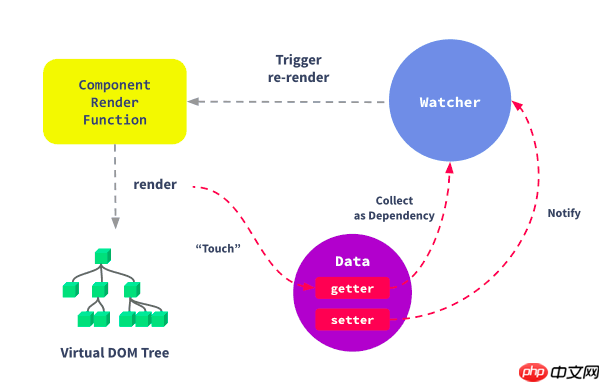Rumah >hujung hadapan web >tutorial js >Vue中computed的实现原理是什么?
Vue中computed的实现原理是什么?
- 不言asal
- 2018-09-14 16:10:063952semak imbas
虽然目前的技术栈已由 Vue 转到了 React,但从之前使用 Vue 开发的多个项目实际经历来看还是非常愉悦的,Vue 文档清晰规范,api 设计简洁高效,对前端开发人员友好,上手快,甚至个人认为在很多场景使用 Vue 比 React 开发效率更高,之前也有断断续续研读过 Vue 的源码,但一直没有梳理总结,所以在此做一些技术归纳同时也加深自己对 Vue 的理解,那么今天要写的便是 Vue 中最常用到的 API 之一 computed 的实现原理。
基本介绍
话不多说,一个最基本的例子如下:
<div id="app">
<p>{{fullName}}</p>
</div>
new Vue({
data: {
firstName: 'Xiao',
lastName: 'Ming'
},
computed: {
fullName: function () {
return this.firstName + ' ' + this.lastName
}
}
})
Vue 中我们不需要在 template 里面直接计算 {{this.firstName + ' ' + this.lastName}},因为在模版中放入太多声明式的逻辑会让模板本身过重,尤其当在页面中使用大量复杂的逻辑表达式处理数据时,会对页面的可维护性造成很大的影响,而 computed 的设计初衷也正是用于解决此类问题。
对比侦听器 watch
当然很多时候我们使用 computed 时往往会与 Vue 中另一个 API 也就是侦听器 watch 相比较,因为在某些方面它们是一致的,都是以 Vue 的依赖追踪机制为基础,当某个依赖数据发生变化时,所有依赖这个数据的相关数据或函数都会自动发生变化或调用。
watch 选项提供了一个更通用的方法来响应数据的变化。当需要在数据变化时执行异步或开销较大的操作时,这个方式是最有用的。从 Vue 官方文档对 watch 的解释我们可以了解到,使用 watch 选项允许我们执行异步操作(访问一个 API)或高消耗性能的操作,限制我们执行该操作的频率,并在我们得到最终结果前,设置中间状态,而这些都是计算属性无法做到的。
下面还另外总结了几点关于 computed 和 watch 的差异:
computed是计算一个新的属性,并将该属性挂载到 vm(Vue 实例)上,而watch是监听已经存在且已挂载到vm上的数据,所以用watch同样可以监听computed计算属性的变化(其它还有data、props)computed本质是一个惰性求值的观察者,具有缓存性,只有当依赖变化后,第一次访问computed属性,才会计算新的值,而watch则是当数据发生变化便会调用执行函数从使用场景上说,
computed适用一个数据被多个数据影响,而watch适用一个数据影响多个数据;
以上我们了解了 computed 和 watch 之间的一些差异和使用场景的区别,当然某些时候两者并没有那么明确严格的限制,最后还是要具体到不同的业务进行分析。
原理分析
言归正传,回到文章的主题 computed 身上,为了更深层次地了解计算属性的内在机制,接下来就让我们一步步探索 Vue 源码中关于它的实现原理吧。
在分析 computed 源码之前我们先得对 Vue 的响应式系统有一个基本的了解,Vue 称其为非侵入性的响应式系统,数据模型仅仅是普通的 JavaScript 对象,而当你修改它们时,视图便会进行自动更新。

data 选项时,Vue 将遍历此对象所有的属性,并使用 Object.defineProperty 把这些属性全部转为 getter/setter,这些 getter/setter 对用户来说是不可见的,但是在内部它们让 Vue 追踪依赖,在属性被访问和修改时通知变化,每个组件实例都有相应的 watcher 实例对象,它会在组件渲染的过程中把属性记录为依赖,之后当依赖项的 setter 被调用时,会通知 watcher 重新计算,从而致使它关联的组件得以更新。Vue 响应系统,其核心有三点:observe、watcher、dep:
observe:遍历data中的属性,使用 Object.defineProperty 的get/set方法对其进行数据劫持;dep:每个属性拥有自己的消息订阅器dep,用于存放所有订阅了该属性的观察者对象;watcher:观察者(对象),通过dep实现对响应属性的监听,监听到结果后,主动触发自己的回调进行响应。
对响应式系统有一个初步了解后,我们再来分析计算属性。
首先我们找到计算属性的初始化是在 src/core/instance/state.js 文件中的 initState 函数中完成的
export function initState (vm: Component) {
vm._watchers = []
const opts = vm.$options
if (opts.props) initProps(vm, opts.props)
if (opts.methods) initMethods(vm, opts.methods)
if (opts.data) {
initData(vm)
} else {
observe(vm._data = {}, true /* asRootData */)
}
// computed初始化
if (opts.computed) initComputed(vm, opts.computed)
if (opts.watch && opts.watch !== nativeWatch) {
initWatch(vm, opts.watch)
}
}
调用了 initComputed 函数(其前后也分别初始化了 initData 和 initWatch )并传入两个参数 vm 实例和 opt.computed 开发者定义的 computed 选项,转到 initComputed 函数:
const computedWatcherOptions = { computed: true }
function initComputed (vm: Component, computed: Object) {
// $flow-disable-line
const watchers = vm._computedWatchers = Object.create(null)
// computed properties are just getters during SSR
const isSSR = isServerRendering()
for (const key in computed) {
const userDef = computed[key]
const getter = typeof userDef === 'function' ? userDef : userDef.get
if (process.env.NODE_ENV !== 'production' && getter == null) {
warn(
'Getter is missing for computed property "${key}".',
vm
)
}
if (!isSSR) {
// create internal watcher for the computed property.
watchers[key] = new Watcher(
vm,
getter || noop,
noop,
computedWatcherOptions
)
}
// component-defined computed properties are already defined on the
// component prototype. We only need to define computed properties defined
// at instantiation here.
if (!(key in vm)) {
defineComputed(vm, key, userDef)
} else if (process.env.NODE_ENV !== 'production') {
if (key in vm.$data) {
warn('The computed property "${key}" is already defined in data.', vm)
} else if (vm.$options.props && key in vm.$options.props) {
warn('The computed property "${key}" is already defined as a prop.', vm)
}
}
}
}
从这段代码开始我们观察这几部分:
-
获取计算属性的定义
userDef和getter求值函数const userDef = computed[key] const getter = typeof userDef === 'function' ? userDef : userDef.get
定义一个计算属性有两种写法,一种是直接跟一个函数,另一种是添加
set和get方法的对象形式,所以这里首先获取计算属性的定义userDef,再根据userDef的类型获取相应的getter求值函数。 -
计算属性的观察者
watcher和消息订阅器depwatchers[key] = new Watcher( vm, getter || noop, noop, computedWatcherOptions )
这里的
watchers也就是vm._computedWatchers对象的引用,存放了每个计算属性的观察者watcher实例(注:后文中提到的“计算属性的观察者”、“订阅者”和watcher均指代同一个意思但注意和Watcher构造函数区分),Watcher构造函数在实例化时传入了 4 个参数:vm实例、getter求值函数、noop空函数、computedWatcherOptions常量对象(在这里提供给Watcher一个标识{computed:true}项,表明这是一个计算属性而不是非计算属性的观察者,我们来到Watcher构造函数的定义:class Watcher { constructor ( vm: Component, expOrFn: string | Function, cb: Function, options?: ?Object, isRenderWatcher?: boolean ) { if (options) { this.computed = !!options.computed } if (this.computed) { this.value = undefined this.dep = new Dep() } else { this.value = this.get() } } get () { pushTarget(this) let value const vm = this.vm try { value = this.getter.call(vm, vm) } catch (e) { } finally { popTarget() } return value } update () { if (this.computed) { if (this.dep.subs.length === 0) { this.dirty = true } else { this.getAndInvoke(() => { this.dep.notify() }) } } else if (this.sync) { this.run() } else { queueWatcher(this) } } evaluate () { if (this.dirty) { this.value = this.get() this.dirty = false } return this.value } depend () { if (this.dep && Dep.target) { this.dep.depend() } } }为了简洁突出重点,这里我手动去掉了我们暂时不需要关心的代码片段。
观察Watcher的constructor,结合刚才讲到的new Watcher传入的第四个参数{computed:true}知道,对于计算属性而言watcher会执行if条件成立的代码this.dep = new Dep(),而dep也就是创建了该属性的消息订阅器。export default class Dep { static target: ?Watcher; subs: Array<Watcher>; constructor () { this.id = uid++ this.subs = [] } addSub (sub: Watcher) { this.subs.push(sub) } depend () { if (Dep.target) { Dep.target.addDep(this) } } notify () { const subs = this.subs.slice() for (let i = 0, l = subs.length; i < l; i++) { subs[i].update() } } } Dep.target = nullDep同样精简了部分代码,我们观察Watcher和Dep的关系,用一句话总结watcher中实例化了dep并向dep.subs中添加了订阅者,dep通过notify遍历了dep.subs通知每个watcher更新。 -
defineComputed定义计算属性if (!(key in vm)) { defineComputed(vm, key, userDef) } else if (process.env.NODE_ENV !== 'production') { if (key in vm.$data) { warn('The computed property "${key}" is already defined in data.', vm) } else if (vm.$options.props && key in vm.$options.props) { warn('The computed property "${key}" is already defined as a prop.', vm) } }因为
computed属性是直接挂载到实例对象中的,所以在定义之前需要判断对象中是否已经存在重名的属性,defineComputed传入了三个参数:vm实例、计算属性的key以及userDef计算属性的定义(对象或函数)。
然后继续找到defineComputed定义处:export function defineComputed ( target: any, key: string, userDef: Object | Function ) { const shouldCache = !isServerRendering() if (typeof userDef === 'function') { sharedPropertyDefinition.get = shouldCache ? createComputedGetter(key) : userDef sharedPropertyDefinition.set = noop } else { sharedPropertyDefinition.get = userDef.get ? shouldCache && userDef.cache !== false ? createComputedGetter(key) : userDef.get : noop sharedPropertyDefinition.set = userDef.set ? userDef.set : noop } if (process.env.NODE_ENV !== 'production' && sharedPropertyDefinition.set === noop) { sharedPropertyDefinition.set = function () { warn( 'Computed property "${key}" was assigned to but it has no setter.', this ) } } Object.defineProperty(target, key, sharedPropertyDefinition) }在这段代码的最后调用了原生
Object.defineProperty方法,其中传入的第三个参数是属性描述符sharedPropertyDefinition,初始化为:const sharedPropertyDefinition = { enumerable: true, configurable: true, get: noop, set: noop }随后根据
Object.defineProperty前面的代码可以看到sharedPropertyDefinition的get/set方法在经过userDef和shouldCache等多重判断后被重写,当非服务端渲染时,sharedPropertyDefinition的get函数也就是createComputedGetter(key)的结果,我们找到createComputedGetter函数调用结果并最终改写sharedPropertyDefinition大致呈现如下:sharedPropertyDefinition = { enumerable: true, configurable: true, get: function computedGetter () { const watcher = this._computedWatchers && this._computedWatchers[key] if (watcher) { watcher.depend() return watcher.evaluate() } }, set: userDef.set || noop }当计算属性被调用时便会执行
get访问函数,从而关联上观察者对象watcher然后执行wather.depend()收集依赖和watcher.evaluate()计算求值。
分析完所有步骤,我们再来总结下整个流程:
当组件初始化的时候,
computed和data会分别建立各自的响应系统,Observer遍历data中每个属性设置get/set数据拦截初始化
computed会调用initComputed函数注册一个
watcher实例,并在内实例化一个Dep消息订阅器用作后续收集依赖(比如渲染函数的watcher或者其他观察该计算属性变化的watcher)调用计算属性时会触发其
Object.defineProperty的get访问器函数调用
watcher.depend()方法向自身的消息订阅器dep的subs中添加其他属性的watcher调用
watcher的evaluate方法(进而调用watcher的get方法)让自身成为其他watcher的消息订阅器的订阅者,首先将watcher赋给Dep.target,然后执行getter求值函数,当访问求值函数里面的属性(比如来自data、props或其他computed)时,会同样触发它们的get访问器函数从而将该计算属性的watcher添加到求值函数中属性的watcher的消息订阅器dep中,当这些操作完成,最后关闭Dep.target赋为null并返回求值函数结果。当某个属性发生变化,触发
set拦截函数,然后调用自身消息订阅器dep的notify方法,遍历当前dep中保存着所有订阅者wathcer的subs数组,并逐个调用watcher的update方法,完成响应更新。
相关推荐:
thinkphp 控制器中 display()步骤实现的原理
Atas ialah kandungan terperinci Vue中computed的实现原理是什么?. Untuk maklumat lanjut, sila ikut artikel berkaitan lain di laman web China PHP!
Artikel berkaitan
Lihat lagi- Analisis mendalam bagi komponen kumpulan senarai Bootstrap
- Penjelasan terperinci tentang fungsi JavaScript kari
- Contoh lengkap penjanaan kata laluan JS dan pengesanan kekuatan (dengan muat turun kod sumber demo)
- Angularjs menyepadukan UI WeChat (weui)
- Cara cepat bertukar antara Cina Tradisional dan Cina Ringkas dengan JavaScript dan helah untuk tapak web menyokong pertukaran antara kemahiran_javascript Cina Ringkas dan Tradisional

